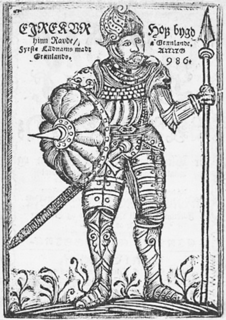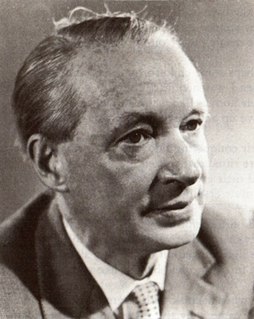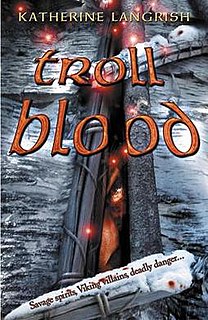
Vinland, Vineland or Winland was an area of coastal North America explored by Vikings. Leif Erikson landed there around 1000 CE, nearly five centuries before the voyages of Christopher Columbus and John Cabot. The name appears in the Vinland Sagas, and describes Newfoundland and the Gulf of Saint Lawrence as far as northeastern New Brunswick. Much of the geographical content of the sagas corresponds to present-day knowledge of transatlantic travel and North America.

Olaf Tryggvason was King of Norway from 995 to 1000. He was the son of Tryggvi Olafsson, king of Viken, and, according to later sagas, the great-grandson of Harald Fairhair, first King of Norway. He is numbered as Olaf I.

Erik Thorvaldsson, known as Erik the Red, was a Norse explorer, described in medieval and Icelandic saga sources as having founded the first settlement in Greenland. He most likely earned the epithet "the Red" due to the color of his hair and beard. According to Icelandic sagas, he was born in the Jæren district of Rogaland, Norway, as the son of Thorvald Asvaldsson. One of Erik's sons was the well-known Icelandic explorer Leif Erikson.

Saint Magnus Erlendsson, Earl of Orkney, sometimes known as Magnus the Martyr, was Earl of Orkney from 1106 to about 1115.

Stromness is the second-most populous town in Orkney, Scotland. It is in the southwestern part of Mainland Orkney. It is a burgh with a parish around the outside with the town of Stromness as its capital.

Leif Erikson, Leiv Eiriksson or Leif Ericson, also known as Leif the Lucky, was a Norse explorer who is thought to have been the first European to have set foot on continental North America, approximately half a millennium before Christopher Columbus. According to the sagas of Icelanders, he established a Norse settlement at Vinland, which is usually interpreted as being coastal North America. There is ongoing speculation that the settlement made by Leif and his crew corresponds to the remains of a Norse settlement found in Newfoundland, Canada, called L'Anse aux Meadows and which was occupied 1,000 years ago.

Freydís Eiríksdóttir was a Norse woman said to be the daughter of Erik the Red, who figured prominently in the Norse exploration of North America as an early colonist of Vinland, which her brother, Leif Erikson, is credited in early histories of the region with the first European contact. The medieval and primary sources that mention Freydís are the two Vinland sagas: the Saga of the Greenlanders and the Saga of Erik the Red. The two sagas offer differing accounts, though Freydís is portrayed in both as a masculine, strong-willed woman who would defy the odds of her society.

Edwin Muir was a Scottish poet, novelist and translator. Born on a farm in Deerness, a parish of Orkney, Scotland, he is remembered for his deeply felt and vivid poetry written in plain language and with few stylistic preoccupations.

Gudrid Thorbjarnardóttir was an Icelandic explorer, born at Laugarbrekka in Snæfellsnes, Iceland.

The Norse exploration of North America began in the late 10th century, when Norsemen explored and settled areas of the North Atlantic including the northeastern fringes of North America. Remains of Norse buildings found at L'Anse aux Meadows near the northern tip of Newfoundland in 1960 date to approximately 1,000 years ago,. with tree-ring analysis of structures at the site dating to the year 1021 and a mean carbon date of 1014. This discovery aided the reignition of archaeological exploration for the Norse in the North Atlantic. This single settlement, located in the island of Newfoundland and not in the North American mainland, was abruptly abandoned.

The Saga of Erik the Red, in Old Norse: Eiríks saga rauða, is an Icelandic saga on the Norse exploration of North America. The original saga is thought to have been written in the 13th century. It is preserved in somewhat different versions in two manuscripts: Hauksbók and Skálholtsbók.

The Lord of the Isles or King of the Isles (Scottish Gaelic: Triath nan Eilean or Rìgh Innse Gall) is a title of Scottish nobility with historical roots that go back beyond the Kingdom of Scotland. It began with Somerled in the 12th century and thereafter the title was held by a series of his descendants, the Norse Gaels rulers of the Isle of Man and Argyll and the islands of Scotland in the Middle Ages. They wielded sea-power with fleets of galleys (birlinns). Although they were, at times, nominal vassals of the Kings of Norway, Ireland, or Scotland, the island chiefs remained functionally independent for many centuries. Their territory included much of Argyll, the Isles of Arran, Bute, Islay, the Isle of Man, Hebrides, Knoydart, Ardnamurchan, and the Kintyre peninsula. At their height they were the greatest landowners and most powerful lords after the Kings of England and Scotland.

George Mackay Brown was a Scottish poet, author and dramatist with a distinctly Orcadian character. He is seen as one of the great Scottish poets of the 20th century.

Thorfinn Karlsefni Thórdarson was an Icelandic explorer. Around the year 1010, he followed Leif Eriksson's route to Vinland in a short-lived attempt to establish a permanent settlement there with his wife Gudrid Thorbjarnardóttir and their followers.

Grœnlendinga saga is one of the sagas of Icelanders. Like the Saga of Erik the Red, it is one of the two main sources on the Norse colonization of the Americas. The Saga of the Greenlanders starts with Erik the Red, who leaves Norway and colonizes Greenland. The Saga also describes the expeditions of Leif Erikson.

Rögnvald Kali Kolsson, also known as Saint Ronald of Orkney, was a Norwegian earl of Orkney who came to be regarded as a Christian saint. Two of the Orkney Islands are named after Rögnvald, namely North Ronaldsay and South Ronaldsay.
Robert Rendall (1898–1967) was a poet, and amateur naturalist who spent most of his life in Kirkwall, Orkney.

Vinland Saga is a Japanese historical manga series written and illustrated by Makoto Yukimura. The series is published by Kodansha, and was first serialized in the youth-targeted Weekly Shōnen Magazine before moving to the monthly manga magazine Monthly Afternoon, aimed at young adult men. As of July 2021, the series has been compiled into twenty-five bound volumes. Vinland Saga has also been licensed for English-language publication by Kodansha USA.

Troll Fell is a children's fantasy novel written by Katherine Langrish, the first in the Troll Trilogy which comprises Troll Fell, Troll Mill and Troll Blood. It is set in Viking Scandinavia and is centred about the eponymous mountain, which is infested with trolls.

Troll Blood is a children's fantasy novel, the third volume of the Troll Trilogy written by Katherine Langrish. It follows the events of Troll Fell and Troll Mill.














